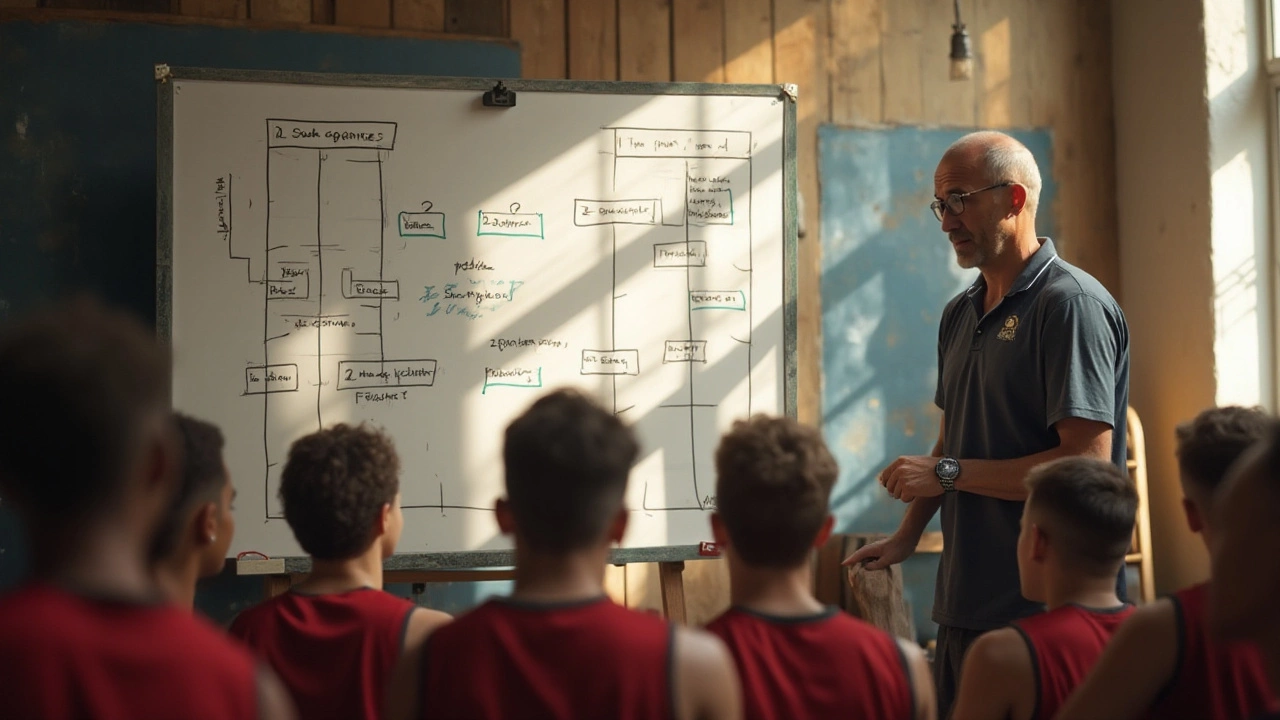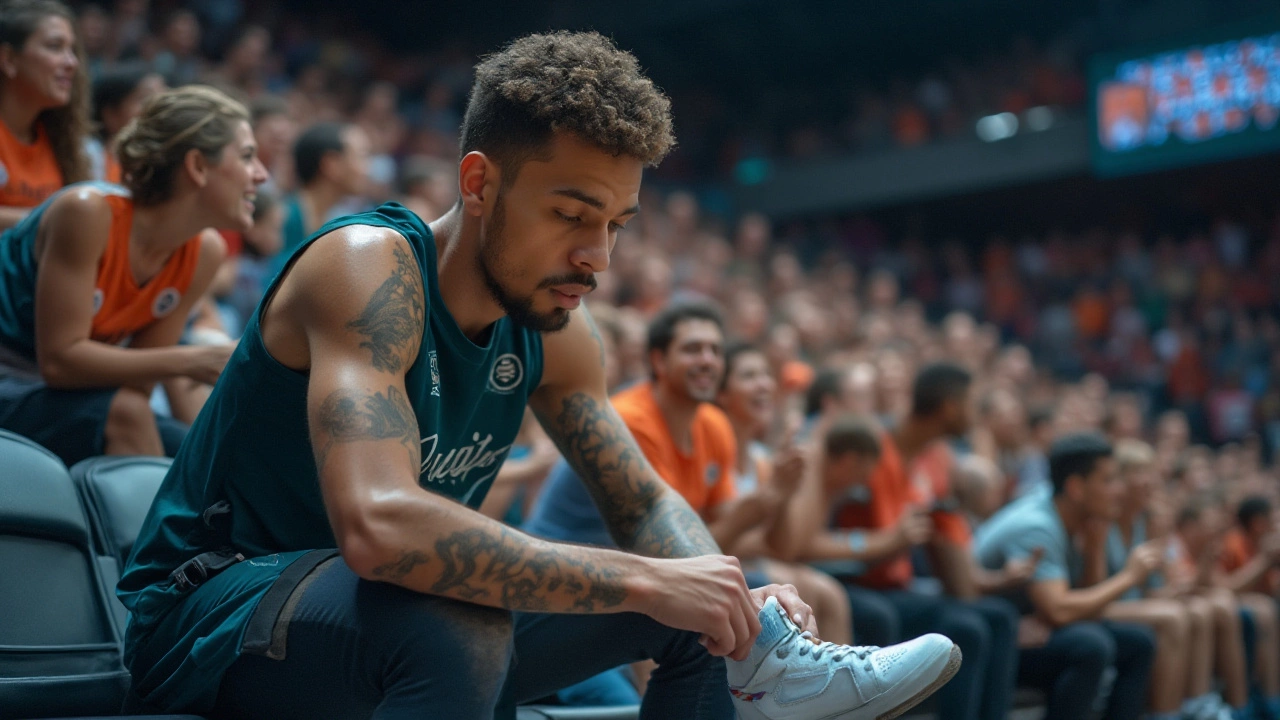Transitioning Beyond League 1: What's Next in Basketball Leagues
 Dec, 15 2024
Dec, 15 2024
Basketball is more than just a game; it's a dynamic journey filled with opportunities and challenges. For many players, League 1 represents an important stepping stone in their career, setting the stage for future success. However, what comes after League 1 can often be as exciting as it is intriguing.
In this article, we will explore the landscape that unfolds once players move beyond League 1. We'll look into the various paths available, examine the hurdles and the exciting prospects that await, and highlight the importance of effective mentorship and coaching in shaping a player’s career. Whether you are an avid basketball follower or an aspiring professional, understanding these transitions is crucial for appreciating the sport's broader arena.
- The Structure of Basketball Leagues
- Pathways After League 1
- Challenges and Opportunities Ahead
- Role of Coaching and Mentorship
- The Future of Aspiring Players
The Structure of Basketball Leagues
When we think about the world of basketball, it's easy to picture the courtside excitement, the fierce competition, and the sound of the buzzer marking the end of each captivating quarter. However, beneath the surface excitement lies a well-oiled machine that is the intricate structure of basketball leagues. These leagues are meticulously designed to provide a pathway for players, beginning with foundational levels like League 1 and leading to the heights of elite professional competition.
At the heart of this structure is a tiered system that accommodates players at various skill levels, ensuring a fair competition and opportunities for growth. League 1 serves as a crucial entry point where players hone their skills, gain experience, and showcase potential. This league is often regional or local, comprising teams that represent communities or regions, and it emphasizes fundamental basketball skills, teamwork, and discipline. These leagues are the bedrock of player development, fostering raw talent and instilling the values essential for advancement.
As players progress, they may find themselves moving into higher leagues that feature increased competition and visibility. These higher leagues not only demand more refined skills but also provide a platform for aspiring players to catch the attention of scouts and agents. Each league level plays a crucial role in preparing players for the challenges of professional-level basketball, with regional and national tournaments offering pivotal exposure. Such structured progression is instrumental in shaping the professional athletes we admire on larger stages.
Moreover, most basketball leagues operate under governing bodies that ensure the orderly conduct of competitions and synchronization with international standards. In the United States, the National Basketball Association (NBA) stands as the beacon for professional basketball, setting benchmarks in terms of quality and professionalism. On the international scene, bodies like FIBA (International Basketball Federation) are paramount in organizing world-class competitions such as the Basketball World Cup. These governing entities not only uphold rules and regulations but also work tirelessly to promote the sport globally.
Clyde Drexler once noted, "As long as you are prepared and ready to go out there and perform, you will be successful." This sentiment resonates strongly through the runways of league structures, signifying that organized preparation and performance in these leagues directly influence rising stars' success on grander stages.
Interestingly, the sports ecosystem and its economic implications are deeply intertwined with these structures. League championships and successful player development result in increased fan engagement, sponsorships, and revenue opportunities, creating a self-sustaining environment that benefits players, teams, and the sporting community at large. Thus, the meticulously crafted structure of basketball leagues is not just a ladder for aspiring players but a comprehensive ecosystem that feeds into the robust world of professional sports.
Pathways After League 1
After the significant milestone of completing League 1, aspiring basketball players stand at a crossroads marinated with possibilities. The landscape of basketball leagues is vast and tiered, designed to facilitate not just competitive play, but also the holistic development of players. As athletes seek progression, they often aim for not just the next league, but a series of calculated steps aligning their career goals, skills, and exposure to skillful play.
Most players transition into semi-professional leagues or advanced division leagues, often determined by their performance, skill level, and potential as seen by scouts. The role of scouts is pivotal, as spotting raw talent and converting it into professional prowess defines much of a player's journey. In fact, successful scouting combined with rigorous training regimes is known to churn out players capable of breathtaking gameplay. The dynamic transition involves navigating through leagues like the G-League in the United States, or securing a place in European Basketball Leagues, each offering its unique set of opportunities.
Sports progression often leans heavily on a player's adaptability to new systems, team dynamics, and diverse play strategies. The leap from League 1 serves as both a testament to their capabilities and an evaluation of their mindset towards continuous improvement. According to a 2023 survey by the International Basketball Federation, nearly 70% of players advancing past League 1 found themselves improving exponentially by engaging with varied styles of play, which is crucial for tactical flexibility. This type of exposure allows players to develop critical elements such as decision-making, situational agility, and leadership on the court.
In countries where basketball is a mainstream sport, rising stars find themselves dotted across different regional and national leagues, aiming not just for championships but chances to showcase their talent on larger platforms. Often, these players participate in invitational tournaments or national team selections which allows them to gain further insights and match their skills with top-tier players globally. In one of his interviews, NBA veteran and coach, Steve Kerr, mentioned,
"League play is just the beginning. It's the young athletes' gateway into a realm so challenging yet rewarding as it reveals their truest potential."
Mentorship plays a hidden yet powerful role as athletes soar higher on the hierarchy of basketball leagues. Seasoned players and coaches who recognize the challenges invariably guiding aspiring players, ensuring that their transition is smooth. Informal mentorship networks often form, where experienced players relate their journeys, thus motivating the younger lot to chase after their dreams tirelessly. The importance of honing one's skill set, adapting seamlessly, and maintaining physical as well as mental fitness cannot be undermined.
Additionally, investment in health and nutrition has surged dramatically, with players now having access to professional establishments focusing on sports health. This emphasis is reflected in the success stories of many who made a mark post-League 1, carving out bright careers as distinguished sports professionals.

Challenges and Opportunities Ahead
Transitioning from League 1 onto higher basketball levels is both a thrilling and arduous journey. One of the primary challenges players face is the intensification of competition. In higher leagues, each match is a test of skills, endurance, and strategic thinking. Many athletes discover that the pace is quicker, opponents are more cunning, and every point scored necessitates strategic finesse. As they climb the ranks, players must hone their skills and adapt to more sophisticated plays, often requiring a deep understanding of game theory and more intense training regimens.
Alongside the increased competition, players are presented with a wealth of opportunities for personal and professional development. Higher leagues often have scouts and representatives from top teams and associations. This visibility can be a fantastic chance for players to showcase their talents and secure positions in elite teams or even international leagues. Many find that by excelling in these games, they can carve out longstanding careers in professional basketball.
The Importance of Adaptability
Adaptability is crucial as athletes transition beyond League 1. Those who adjust quickly to new playing styles and team dynamics tend to excel. Players are challenged to develop not only their physical prowess but also their mental resilience. The mental aspect of the game grows increasingly important as they face seasoned players. Maintaining composure under pressure and making quick, effective decisions is often what separates success from failure.
A staggering 72% of professional players surveyed in 2023 indicated that mental strength was as vital as physical training in their progression. This statistic underscores the significance of fortifying psychological endurance alongside traditional training methods.
Leveraging Coaching and Support
According to James Naismith, a celebrated figure in basketball history, "A good coach will make his players see what they can be rather than what they are."
The role of coaching and mentorship cannot be overstated in navigating these challenges. While the terrain might be rough, having a dedicated support team can provide the necessary guidance to navigate this path successfully. Coaches often offer invaluable insights, strategizing techniques, and motivational support to help players maintain their trajectory toward success. Mentors, often seasoned retirees from the sport, provide perspective and wisdom that can prove crucial for overcoming hurdles. This guidance can make a significant difference, equipping players with strategies to leverage their strengths and address weaknesses.
Ultimately, while challenges abound in these upper echelons, the opportunities for growth and achievement are equally vast. For those who can persevere and adapt, advancing beyond League 1 opens doors to a vibrant world of professional basketball that holds the promise of immense personal and career fulfillment. Enabling a stronger, more dramatic rise, this stage of a player's journey can often define their legacy in the sport.
Role of Coaching and Mentorship
The transition beyond League 1 in basketball is a pivotal stage in an athlete's career. At this juncture, coaching and mentorship play an invaluable role, acting as the guiding lights that help players navigate the complexities of advanced levels. The impact of a seasoned coach can often mean the difference between a player who merely participates and one who excels. A coach’s responsibility is multifaceted, encompassing strategy development, skills enhancement, and psychological encouragement. The right coach fosters a nurturing environment that challenges athletes to refine their strengths while addressing their weaknesses. This holistic approach ensures that players not only perform well on the court but also grow as individuals. Emphasis on character building is crucial, as it prepares athletes to handle both victories and setbacks with equal poise.
Mentorship complements coaching by providing players with a more personal and tailored support system. Unlike coaching, which often focuses on technical and strategic elements, mentorship delves into the personal development of a player, targeting areas like confidence building, decision making, and resilience. Many successful athletes credit their mentors for imparting wisdom that extends beyond basketball, affecting their approach to life’s challenges. A mentor who has played at higher levels can provide insights that are not found in playbooks, offering practical advice based on personal experience. A quote from the legendary coach John Wooden resonates here:
"A good coach can change a game. A great coach can change a life."This reflects the profound impact that an effective mentor-coach duo can have on a player's journey.
The synergy between coaching and mentorship fosters a balanced development framework, where the technical, strategic, and personal growth aspects are all prioritized. In high-stakes basketball leagues, where the pressure to perform is immense, having this supportive network can be the anchor athletes need to stay grounded and focused. For young players, entering these advanced leagues can be daunting, and without the right guidance, many may falter. Coaches and mentors act as motivators, equipping players with the mental fortitude necessary to thrive in competitive environments. They cultivate resilience, teach stress management techniques, and instill a work ethic that prepares players for the rigors of professional sports.
We must recognize the evolving nature of basketball coaching, which is increasingly data-driven. Modern coaches employ analytics to tailor training regimens specific to each player’s needs, optimizing performance outcomes. Aspects such as shot selection, defensive maneuvers, and stamina management are finely tuned through detailed analytics. Yet, the human element remains irreplaceable. A coach’s intuition, honed by years of experience, can read in-game situations and players' mindsets in a way that data alone cannot. This blend of traditional wisdom and modern technology is a testament to how dynamic the role of coaching has become. Additionally, mentorship today often crosses geographical boundaries, with mentors connecting with their protégés through digital platforms, ensuring that support is accessible regardless of location.

The Future of Aspiring Players
For aspiring basketball players, navigating the future can feel like walking through a complex maze. Beyond League 1, the path narrows as competition intensifies, demanding not only skill but also strategic career planning. While talent can open doors, understanding the nuances of different basketball leagues is crucial for making informed decisions. Many young athletes dream of progressing to international leagues or even the NBA, but every step requires perseverance and a willingness to adapt to new challenges. Professional enhances don't just test physical prowess; they demand mental resilience and adaptability, often requiring players to continuously upgrade their game through rigorous training and strategic gameplay. Recognizing the importance of mental health and maintaining it is equally essential, as the pressure to perform at higher levels can take a toll on even the most seasoned players.
Guidance from mentors and coaching staff plays a pivotal role, acting as invaluable resources that help players chart their trajectory. The role of a coach isn't limited to merely improving skills; it's about molding an inherently resilient mindset. As players advance, mentorship becomes instrumental in navigating the complexities of the sports industry. Not only do they provide insights into game strategies, but also offer lessons in professionalism and dealing with the inevitable setbacks. Leveraging these relationships often results in better opportunities such as scholarships or trials for significant leagues, where the competition is fierce, and only those equipped both physically and mentally can truly thrive.
"Success in basketball is as much about how you navigate your path as it is about outplaying your opponent," says Mike Krzyzewski, legendary basketball coach.
The involvement of supportive networks, including families, agents, and trainers, is equally significant. They form a backbone that supports the athlete both on and off the court. With the digital age shaping modern sports, social media, and technology offer platforms for players to showcase their talents, creating unique pathways to recognition that weren't available to previous generations. Athletes now harness the power of digital presence to secure brand partnerships and endorsement deals, which can be transforming for their career trajectory. For young players, understanding the landscape of sports progression involves more than just mastering the ball; it's about crafting a compelling narrative and carving out unique spaces in an ever-evolving sporting world.
Various emerging platforms offer robust training modules and virtual coaching experiences, enabling players from remote areas to connect with seasoned coaches worldwide. Such technological advancements make it easier for players to access resources that can elevate their skill set, leveling the playing field in remarkable ways. Structured training programs tailored to individual needs can also be accessed through specialized apps, which allow aspiring professionals to track their progress and areas for improvement systematically. These digital innovations are not only broadening access but also democratizing opportunities to a significant extent. As technology integrates deeply into sports, staying ahead involves being tech-savvy and using these tools to gain a competitive edge.
Lastly, the landscape of league transition requires players to continually scout options and reassess goals. Many players find opportunities in lesser-known international leagues which offer a different kind of exposure and development opportunities. Europe's leagues, for example, have been nurturing grounds for many NBA players, providing a platform where talent can flourish with the flair and style that might be constrained in some domestic leagues. This international exposure can be critical in shaping a player's versatility and understanding of global play styles, increasing their desirability to major teams. Being open to such transitions can mean the difference between staying stagnant and reaching new heights. Amidst these challenges and opportunities, the key takeaway for aspiring athletes is that the future in basketball does not follow a single path but is full of varied avenues waiting to be explored.